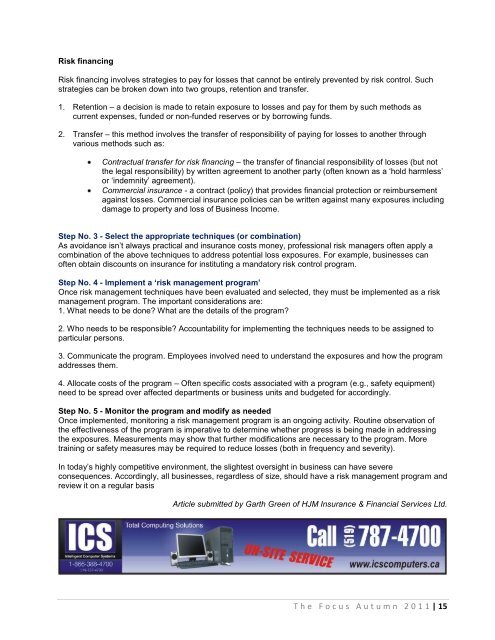7 ways to give your business a professional look Risk Management:
7 ways to give your business a professional look Risk Management:
7 ways to give your business a professional look Risk Management:
Create successful ePaper yourself
Turn your PDF publications into a flip-book with our unique Google optimized e-Paper software.
<strong>Risk</strong> financing<strong>Risk</strong> financing involves strategies <strong>to</strong> pay for losses that cannot be entirely prevented by risk control. Suchstrategies can be broken down in<strong>to</strong> two groups, retention and transfer.1. Retention – a decision is made <strong>to</strong> retain exposure <strong>to</strong> losses and pay for them by such methods ascurrent expenses, funded or non-funded reserves or by borrowing funds.2. Transfer – this method involves the transfer of responsibility of paying for losses <strong>to</strong> another throughvarious methods such as:Contractual transfer for risk financing – the transfer of financial responsibility of losses (but notthe legal responsibility) by written agreement <strong>to</strong> another party (often known as a „hold harmless‟or „indemnity‟ agreement).Commercial insurance - a contract (policy) that provides financial protection or reimbursementagainst losses. Commercial insurance policies can be written against many exposures includingdamage <strong>to</strong> property and loss of Business Income.Step No. 3 - Select the appropriate techniques (or combination)As avoidance isn‟t al<strong>ways</strong> practical and insurance costs money, <strong>professional</strong> risk managers often apply acombination of the above techniques <strong>to</strong> address potential loss exposures. For example, <strong>business</strong>es canoften obtain discounts on insurance for instituting a manda<strong>to</strong>ry risk control program.Step No. 4 - Implement a ‘risk management program’Once risk management techniques have been evaluated and selected, they must be implemented as a riskmanagement program. The important considerations are:1. What needs <strong>to</strong> be done? What are the details of the program?2. Who needs <strong>to</strong> be responsible? Accountability for implementing the techniques needs <strong>to</strong> be assigned <strong>to</strong>particular persons.3. Communicate the program. Employees involved need <strong>to</strong> understand the exposures and how the programaddresses them.4. Allocate costs of the program – Often specific costs associated with a program (e.g., safety equipment)need <strong>to</strong> be spread over affected departments or <strong>business</strong> units and budgeted for accordingly.Step No. 5 - Moni<strong>to</strong>r the program and modify as neededOnce implemented, moni<strong>to</strong>ring a risk management program is an ongoing activity. Routine observation ofthe effectiveness of the program is imperative <strong>to</strong> determine whether progress is being made in addressingthe exposures. Measurements may show that further modifications are necessary <strong>to</strong> the program. Moretraining or safety measures may be required <strong>to</strong> reduce losses (both in frequency and severity).In <strong>to</strong>day‟s highly competitive environment, the slightest oversight in <strong>business</strong> can have severeconsequences. Accordingly, all <strong>business</strong>es, regardless of size, should have a risk management program andreview it on a regular basisArticle submitted by Garth Green of HJM Insurance & Financial Services Ltd.T h e F o c u s A u t u m n 2 0 1 1 | 15







